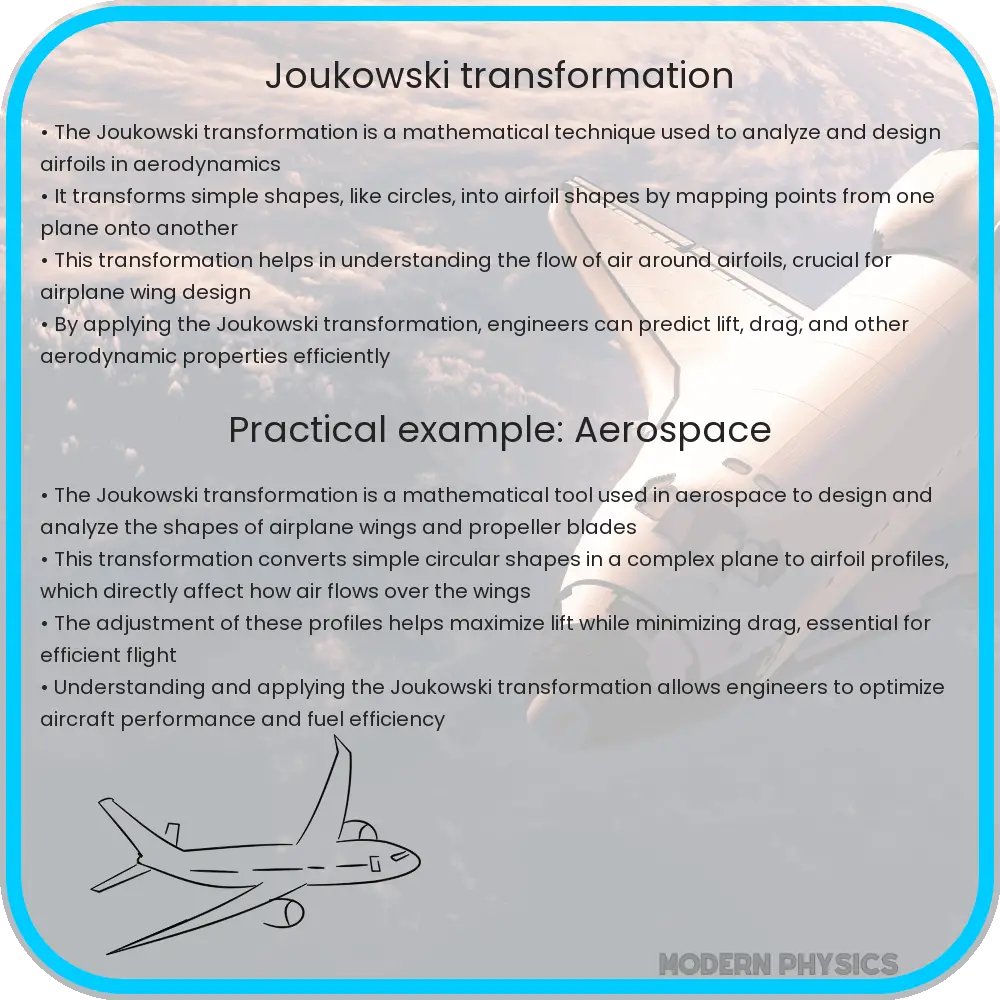A mathematical technique in aerodynamics, the Joukowski transformation is pivotal for analyzing airflow around airfoils to optimize flight characteristics.

Understanding the Joukowski Transformation in Aerodynamics
The Joukowski transformation is a mathematical technique used extensively in aerodynamics to analyze and compute the flow around airfoils. This transformation helps in understanding how lift is generated and how the airflow behaves around different shapes. Developed by the Russian scientist Nikolai Joukowski, this mathematic formula plays a pivotal role in the design and analysis of wings and blades in aircraft and turbines.
Basics of the Joukowski Transformation
At its core, the Joukowski transformation is a conformal mapping technique used to transform flow patterns from a simple geometry to more complicated shapes. It starts with the flow around a basic shape, such as a circle, and mathematically transforms this flow into the flow around an airfoil. The mathematical expression for the Joukowski transformation is:
\[ z = z + \frac{1}{z} \]
where \( z \) is a complex number representing points in the flow field. The transformation relies on the properties of complex function theory, utilizing the interactions between real and imaginary parts to model the physical behavior of airflows.
Application in Aerodynamics
The primary application of the Joukowski transformation in aerodynamics is in the study and design of airfoils. An airfoil’s shape critically influences its ability to produce lift — the force that allows an aircraft to rise into the air against gravity. Engineers use the Joukowski transformation to predict how air will move around an airfoil at different angles of attack, speeds, and conditions. This analysis is crucial for optimizing the airfoil shape to achieve the necessary lift and drag characteristics for specific flight requirements.
Lift and the Joukowski Airfoil
The Joukowski airfoil is derived from the transformation of a circle in the complex plane. When a circle, offset from the origin and with a diameter intersecting the origin, is transformed via the Joukowski function, the resulting shape resembles a typical airfoil. This geometrical transformation also sheds light on how varying parameters will affect airfoil performance, including thickness, camber, and overall lift capacity.
To better understand how lift is generated, consider the circulation theory of lift. It’s established that for an airfoil to generate lift, the air traveling over the top surface must move faster than the air passing beneath. This difference in speed creates a lower pressure on the upper surface and thus lift. The Joukowski transformation helps quantify the circulation around the airfoil, which correlates directly with lift.
By using parameters in the Joukowski transformation, such as the position and size of the initial circle, engineers can design airfoils that optimize the flow conditions and lift characteristics. This mathematical approach enables the precise adjustment of airfoil features, balancing the lift and drag forces to meet specific aerodynamic performance criteria.
The implications of the Joukowski transformation extend beyond mere theoretical calculations. It is a vital tool in the computational fluid dynamics (CFD) simulations used in the iterative design process of modern aerodynamic structures. Through these simulations, aerodynamicists can visualize flow patterns, pressure distributions, and potential problem areas, guiding improvements in airfoil design.
Challenges and Innovations in Applying the Joukowski Transformation
Despite its powerful capabilities, the use of the Joukowski transformation in practical applications is not without challenges. The transformation assumes an ideal fluid—thus ignoring the effects of viscosity, which in real-world scenarios can alter aerodynamic performance significantly. Engineers must therefore combine the insights gained from Joukowski models with additional computations or empirical data that take viscous effects into account.
Furthermore, advancements in computational power have enabled more sophisticated techniques, such as Computational Fluid Dynamics (CFD), to take precedence over traditional methods for some applications. These methods give a more detailed and comprehensive analysis of fluid behaviors and can model complex phenomena including turbulence, shock waves, and boundary layer transitions, which are beyond the scope of the Joukowski transformation.
However, the simplicity and elegance of the Joukowski transformation continue to make it a crucial part of aerodynamics education and fundamental research. It also finds utility in optimizing preliminary designs before they are refined with more detailed simulations.
Conclusion
The Joukowski transformation remains a staple in the field of aerodynamics, offering a foundational tool for understanding and designing airfoil structures. By transforming simple circular flow into the complex flow conditions around an airfoil, it provides essential insights into lift generation and aerodynamic performance. While modern computational methods have surpassed the Joukowski transformation in detail and scope, its educational value and application in initial design stages uphold its relevance.
As engineering challenges evolve and demand more sophisticated solutions, the integration of traditional methods like the Joukowski transformation with cutting-edge technologies creates a balanced approach. This synergy enhances our ability to design more efficient, effective, and sophisticated aircraft and turbines, propelling the future of aerospace engineering. The journey from basic theoretical concepts such as the Joukowski transformation to high-tech applications illustrates the dynamic and continually evolving nature of scientific inquiry and technological development in aerodynamics.
